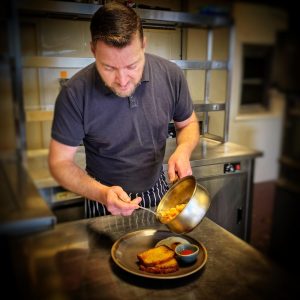For the past two months, Blackmoor Dining Room has been quietly going about its business in a hidden backroom of Moor Allerton Golf Club. A happy marriage of work and play, the restaurant is the brainchild of Paul Bolster, a member of 12 years, jaded by forgettable club dining experiences after long Sunday afternoons hitting pristine greens.

Members and non-members are welcome – but it pays to be in the know. Navigate your way past mahogany plaques gilded with the names of club champions past, to reach a nondescript door. Behind it you’ll find a hidden gem of a space, torn apart and lovingly put back together in an exercise in pared back elegance – a collaborative effort between local craftspeople who know the club and respect its history.
A black feature wall frames sweeping views of manicured fairways in double height windows, ferns and hanging trellises lit by industrial geometric lamps suspended above a herringbone floor of polished oak. Julie Stanton from Oakwood Vintage, her husband a member, has been brought in to build the bar and reupholster the seating with a pop of colour. A wall of bright, abstract floral prints from local artist Sarah Thornton brings a vibrant energy to the room. The only original fixtures that remain are domed black lampshades looming over stripped-back oak tables, lending the air of a private member’s club.
There’s a clear vision in the kitchen: fine dining without pretension. The menu puts a twist on British and modern European classics, rotating monthly with the seasons. Mindful of the club’s Jewish history, pork and shellfish are notable absences.
The north’s answer to Heston Blumenthal, head chef James Dempsey possesses a frightening knowledge of the dark arts of gastronomic alchemy. Pushing the boundaries of food art, scientific techniques using natural ingredients are invoked to bend substances to his will. Parts of the kitchen wouldn’t look out of place in a chemistry lab.

Dishes are delivered with finesse, emulsions and gels dotted and smeared sparingly to dramatic effect. Rather than flexing his culinary muscle, it’s clear each stylistic element has been thought out to bring its weight to bear on the overall flavour profile of the dish. Never satisfied to sit still, he admits to tinkering with recipes week-to-week in search of perfection.
The small plates fad thankfully hasn’t found its way here. The rule of Yorkshire hospitality reigns supreme: no one leaves hungry. Conscious of trends but shunning irritating hipster quirks, to everyone’s relief, food is served on plates – not a wooden serving board in sight. Prices are surprisingly keen for the calibre of fine dining on display: expect change from £30 a head for three courses. This is welcome value unseen by the likes of its city centre counterparts.
The kitchen does not stray beyond its means: the menu a single page cataloguing a handful of dishes done well. For starters, the tang of a beetroot tartare is offset by a yolk of sweet mango, bound using the molecular technique of spherification. Much like the real thing, the luminous dome quivers in anticipation of your spoon, trickling into the beetroot on contact. A delicate scrape of buttermilk puree adorned with nasturtium is begging to be mopped up with crisped triangles of melba toast.
A reimagined gravadlax sees tart drupulets of balsamic caviar perched atop a generous wedge of dill-flecked salmon, ringed by a deconstructed salad of heirloom tomatoes and grilled cucumber, punctuated with piped globes of mint raita.
The signature dish of slow roast beef is somewhat of a misnomer. Palace ribs, known locally as ‘rands’ – the lean muscle of beef between shoulder and brisket – is a tough cut to crack. Get it right and there’s a whole world of deep mineral flavour to be explored. James’ answer is to ditch the oven, and sous vide low and slow.
The beef emerges blushing inside, melt-in-the-mouth and packed with flavours of garlic and thyme. The rich liquor accrued during its lengthy schvitz gives the red wine sauce a meaty shot in the arm. It arrives with a panache of seasonal vegetables, glossed with butter and roasted until their edges are caramelised.

Harissa chicken arrives nestled in a mound of pad thai rice, daubed with a concentrated lemon and lime gel packing a lip-smacking hit of zest. James sidesteps the pitfalls of keeping delicate breast moist and flavourful as dark meat is wont, the bone-in supreme pan fried and swiftly blasted in the oven skin-down until crisp.
A lemon meringue pie’s puckering sharpness is addictive; the scattering of candied popcorn dust and toffee shards keeping you coming back for more. Mary Berry acolytes: there are no soggy bottoms here.
During his days shaking pans at Halifax gastropub Long Can Hall, James earned unlikely internet fame as the inventor of the ‘British burrito’: roast beef and vegetables swaddled in a Yorkshire pudding wrap. Channelling food illusionist Ben Churchill, whose greatest hits include a vanilla panna cotta disguised to look like an ashtray, James has created a dessert in similarly playful vein.
This is beans on toast – but not as you know it. A slice of lemon sponge is blowtorched until the surface resembles toast. Marzipan is rolled into beans and run through blood orange sauce. Twin layers of panna cotta form the whites of the egg, the mango yolk making a timely reappearance. On the side, a pot of raspberry coulis ketchup. The result is a symphony of flavour combinations, creamy panna cotta and comforting sponge set off against citrus zest and the sweet hit of marzipan. Your eyes tell you one thing, your taste buds another; it’s a mind-boggling experience that must be tried to be believed.
Blackmoor Dining Room may well be Leeds’ best kept secret – it’s almost a shame to spill the beans.
To make a reservation, visit Theblackmoor.co.uk

